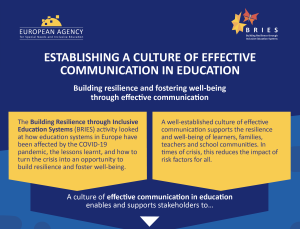This area contains multimedia materials including key messages, presentations and links to videos from the EASNIE YouTube channel.
Quality Assurance, Monitoring and Accountability: Collection and use of data in inclusive education
EASNIE’s Quality Assurance, Monitoring and Accountability (QAMA) activity aims to identify the essential elements of a framework that brings all aspects of an education system together. Data collection and use have a critical role in this framework, as Dr Verity Donnelly explains in this video.
TSI - Shaping Inclusive Education: Combatting Disparities in Italy, Portugal and Spain
Agency
The objective of the 'Combatting Disparities in Access to Inclusive Education in Italy, Portugal and Spain’ project (2022–2024) was to support the Portuguese Ministry of Education, the Italian Ministry of Education and Merit and the Spanish Ministry of Education, Vocational Training and Sport.
Webinar 1: Monitoring and evaluation at school level
This webinar explores the importance of monitoring and evaluation in enhancing educational practices and ensuring that all learners have access to quality education.
Webinar 2: Collaborative working and thinking across all levels of the education system
This webinar explores the importance of collaboration in education.
Webinar 3: Effective strategies for resource allocation and use at school and regional levels
This webinar explores essential approaches for optimising resources in inclusive education.
Implementation of the European Child Guarantee – Promoting Inclusive Education in Greece, phase 2
The ‘Implementation of the European Child Guarantee – Promoting Inclusive Education in Greece, phase 2’ project aimed to assist the Greek Ministry of Education, Religious Affairs and Sports (MERAS). This video highlights the main achievements and milestones of the project, funded by the European Union via the Technical Support Instrument (TSI).
The Agency's Vision for Inclusive Education Systems
Our ultimate vision for inclusive education systems is to ensure that all learners of any age are provided with meaningful, high-quality educational opportunities in their local community, alongside their friends and peers.
BRIES Guidance for Establishing a Culture of Effective Communication in Education video
This video presents the Guidance for Establishing a Culture of Effective Communication in Education, which is the Building Resilience through Inclusive Education Systems (BRIES) activity’s main output.
Infographic: Building Resilience through Inclusive Education Systems

The Building Resilience through Inclusive Education Systems (BRIES) activity looked at how education systems in Europe have been affected by the COVID-19 pandemic, the lessons learnt, and how to turn the crisis into an opportunity to build resilience and foster well-being.
